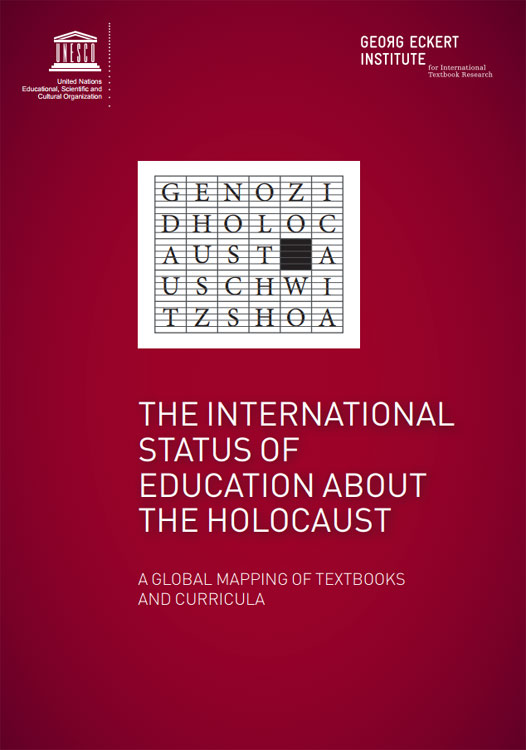
The International Status of Education about the Holocaust
Sunday to Thursday: 09:00-17:00
Fridays and Holiday eves: 09:00-14:00
Yad Vashem is closed on Saturdays and all Jewish Holidays.
Entrance to the Holocaust History Museum is not permitted for children under the age of 10. Babies in strollers or carriers will not be permitted to enter.

The International Status of Education about the Holocaust
The International Status of Education about the Holocaust: A Global Mapping of Textbooks and Curricula.
Published by the United Nations Educational, Scientific and Cultural Organization (UNESCO) and the Georg Eckert Institute for International Textbook Research, 2015, pp. 238. ISBN 9789231000331
As time passes, interest in learning more about the Holocaust appears to be continuously on the rise. For example, the expected number of visitors to the Auschwitz-Birkenau State Museum in 2015 will reach 1.7 million – not including hits on their website. According to a recent study by the Institute of Education of the Centre for Holocaust Education of University College London about English pupils' knowledge of the Holocaust, students seem to be gaining information from a wide range of sources, especially from films and the Internet. In light of these findings, experts on Holocaust education may wish to consider the impact of textbooks in teaching about this watershed event in world history. Despite the possible decreasing significance of textbooks as student resources for acquiring information about the Holocaust, this wide-scale assessment of Holocaust-related topics, terminology and texts in school curricula - undertaken by UNESCO, based in Paris, and the Georg Eckert Institute, based in Germany – is an extremely important book.
According to the authors, “The Holocaust is part of the curriculum in approximately half of the countries investigated, with contexts and terminologies varying. The Holocaust is located most frequently in history curricula in the context of the Second World War, but features in repeated instances in the context of the issue of ‘human rights’ or ‘human rights violations’, thus forming part of teaching in social studies or, more rarely, ethics education or philosophy. The event is referred to primarily using the term ‘Holocaust’, with isolated preferences of the term ‘Shoah’ or use of both terms side by side. In several instances, neither ‘Holocaust’ nor ‘Shoah’ find use; instead, an unambiguous description of the event appears, using alternative terms such as ‘extermination’ or ‘genocide of the Jews.’ (p. 38).
This pioneering study sheds light on national narrative patterns on a global scale, providing recommendations to policy makers and curriculum developers. The publication provides helpful color maps regarding how school curricula reference the Holocaust on a worldwide scale, as well as per continent (pp. 42-8). Readers with limited time may wish to consult an 18-page executive summary highlighting the goals, data and methods, typology of textbook references, spotlights on curricula in 26 specific countries and practical suggestions based on the research findings.
Overall, many of the recommendations outlined in this volume echo a number of the IHRA guidelines on How to Teach about the Holocaust, as well as the educational approach developed by Yad Vashem. For example, in the context of Protagonists in Section 7.3, the authors express concern that "the quantitative and qualitative imbalance of textual and visual representations of protagonists in favor of perpetrators… not only marginalizes other protagonists but also ascribes human qualities to perpetrators while naming victims as objects of other actions." As a result of this analysis, the authors recommend focusing on the pre-war and post-war periods, as well as providing "insight into experiences of victims, bystanders, rescuers and resisters" (p. 177). They also encourage readers to "Reduce the space given to Hitler while underscoring multiple [ideological, political, psychological or economic] factors or causes with which the even may be explained." (p. 178).
This study also related indirectly to the importance of educational standards in media literacy. For instance, Section 7.6 highlighted that "meanings generated by the selection and sequences of images between texts and images are often incongruous" in the reviewed textbooks (p. 180). This study thereby recommends that curriculum developers "provide information which determines the relation between images, the purposes for which images were created, and the temporal and spatial context in which they are to be understood today." (Ibid.) Since many well-known Holocaust-related images that appear in history curricula were created by German perpetrators for propaganda purposes, this recommendation is particularly noteworthy.
Practitioners interested in designing questionnaires to conduct their own local research will find the appendix and the bibliography of this book extremely useful. Diplomats and decision makers in ministries of education may also be very interested in the summary of this comparative study.
This curriculum review is highly recommended reading. One hopes that policy makers in various nations will take stock of these recently published findings and that additional international organizations will conduct further research in the field of Holocaust education.

Thank you for registering to receive information from Yad Vashem.
You will receive periodic updates regarding recent events, publications and new initiatives.

"The work of Yad Vashem is critical and necessary to remind the world of the consequences of hate"
Paul Daly
#GivingTuesday
Donate to Educate Against Hate


Worldwide antisemitism is on the rise.
At Yad Vashem, we strive to make the world a better place by combating antisemitism through teacher training, international lectures and workshops and online courses.
We need you to partner with us in this vital mission to #EducateAgainstHate
The good news:
The Yad Vashem website had recently undergone a major upgrade!
The less good news:
The page you are looking for has apparently been moved.
We are therefore redirecting you to what we hope will be a useful landing page.
For any questions/clarifications/problems, please contact: webmaster@yadvashem.org.il
Press the X button to continue



